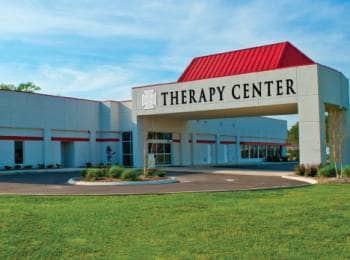
Brian J. Adams, PT, DPT, OCS, CSCS, works on strengthening exercises with an athlete who is recovering from a sports injury. Assuring that all therapy and rehab exercises are performed with optimum alignment and biomechanics is crucial for successful return to sport.
by Brian J. Adams, PT, DPT, OCS, CSCS
It is a time-honored tradition of sports: Athletes train hard and play hard; sustain an injury that forces them out of the world they know towards an environment of rest and rehab—led by a medical team—with the hopes to train hard and return to full competition as soon as possible. These injuries can be a short-term setback or result in a career-changing process. The athletes that therapists treat can be the hero of their own story, now being pushed into a call to adventure, with many refusing that call, wanting only to stay in the athletic arena they know and love.
As sports rehabilitation specialists, physical therapists are the mentors and sages along this journey. We pull from our knowledge and experience in order to give our best efforts for our patients. But the athletic population can be a very determined population to work with. Any therapists who have ever worked with a motivated athlete have been faced with the conversation in the clinic or training room about when this journey will be complete. Or, more specifically, have been asked by an athlete, “When can I return to competition?”
Injury Management: A Team Process
Every day, therapists do their best to help athletes prevent injuries sustained during training and competition. But once the injury occurs, it is the duty of the health care team to manage the process, the expectations of the athlete (and coach/team) and the outcomes of the rehabilitation process. It is of significant importance that our athletes understand the progression of the injury, the extent of the damage, and what it will take to get them back to full participation. Ultimately, that return-to-performance decision is a collaboration between the athlete, the health care providers, and the coach/team. This decision is continually being considered and evaluated over the progression of the patient. The ability of the athlete’s injured tissue to accept the load placed on it during training and competition is at the heart of the conversation.
At the onset of injury, the initial evaluation allows us to appropriately assess the extent of the damages while establishing short-term and long-term goals. Oftentimes the athlete presents with a painful, stiff and protected posture they adopt to protect their damaged tissues. The therapist’s initial goals center on restoring mobility of the affected joints and surrounding tissues, improving flexibility and then increasing active stability of the region. During the process we address pain that can affect movement patterns and neuromuscular inhibition resulting in muscle weakness.
Oftentimes, once these short- and long-term goals are met, the athlete is given clearance to return to activity. This return, for many, is viewed as the departure from rehab and the sense of being thrown back into the sports arena. But there is a paradigm shift taking place.
Biopsychosocial Aspects of Readiness
There is an equally important progression happening with direct focus on the athlete’s return to pre-injury performance: taking into consideration their progressive return to activity, on to return to sport, and ultimately return to peak performance. Beyond evaluating the structural healing, the health care team needs to evaluate the biopsychosocial aspects of the athlete’s “readiness,” knowing that oftentimes athletes never fully return to their pre-injury performance levels—or worse, they sustain a re-injury. Oftentimes, even after an athlete is cleared for sport, they harbor fear and reservation about their preparedness to take on the training load and competition, or fall victim to re-injury.
During the First World Congress in Sports Physical Therapy meeting in 2016, a team of expert clinicians created a consensus statement about return to sports criteria.1 Through this process they helped to identify and prioritize key components of the return to sport progression. It also took into consideration the ability to allow for return to participation for the athlete, developing into a return to sports and ultimately return to full performance. This process also allowed for careful consideration of all the decision-makers about how to best prepare an athlete for return to sport.
This same progression must also take into consideration the athlete’s psychological and psychosocial state as it relates to their injury. Therapists need to address any fears the athletes may have about returning to sport, in combination to outside stressors that are affecting their ability to thrive and focus. Podlog et al discuss the need to look at three other key aspects to the athlete’s return to sport preparation: competence, relatedness and autonomy.2 These aspects take into account their ability to set goals, relax and reduce anxiety, and perform mental imagery. It places value on their social support and team support, which is especially important with scholastic team sports. And lastly, looking at the ability of the athlete to collaborate and participate in the decision-making process.
Sport-Specific Training
In the sports rehab clinic, there is another progression that is taking place. Specific to the athlete and his or her goals, it is designed to optimize their re-entry into their sport with the highest amount of sport-specific training. The tools therapists utilize are designed not only to progressively load the damaged tissues, but also to consider the progressive loading for the mental aspects of the athlete.
For a moment, let’s consider athletes who run as a part of their sport. If their injury affects how they manage loading during running, they need to somehow understand that their tissue is ready to withstand the activity of running. They need to trust their tissue, and trust their body. To better illustrate this concept, one may imagine testing ice before first stepping onto it, or testing the temperature of water in a swimming pool before jumping in. Both examples illustrate ways of progressively loading while considering the fear that the individual may have regarding the risk of the activity. In that sense, the therapist’s goal is to try and figure out how to create an environment where athletes can slowly test the waters before they jump in. In many cases, the tools have already been created, such as the use of the newly designed unweighting treadmills that use positive pneumatic pressure or support bands as a way to progressively add or reduce load with significant precision. Running on these treadmills can build a foundation for the athlete to continue to increase load and re-assess their tolerance after each session, with the goal being a full return to running over ground.
For athletes who require explosive movements as a part of their peak performance, therapists need to progressively train not only their strength and power, but their neuromuscular response with jump training and plyometrics. This is standard practice for many athletes, but how do we as clinicians build their confidence with movement and remove fear while facilitating their speed and response time? For many athletes, to simply ask them to begin jumping rope or perform a box jump would cause them to sweat with some level of anxiety, so the challenge again becomes progressive loading. The use of a standard leg press is good for strength and power, but the need for a supine leg press that has a progressive/elastic load is ideal for the development of jump and plyometric training. Movements on these machines can be lightly loaded with short, quick movements or progressively loaded for jump training and soft landings. Moving for double to single limp movements and adding a dynamic landing platform also allows for optimal preparation of the neuromuscular system while allowing for development of the athlete’s confidence.
Overcoming Overuse
Building confidence in endurance athletes is also a task to conquer prior to full return to sport. A majority of injuries in this type of athlete can be attributed to overuse. This can happen either by overloading the tissue with a sudden ramp-up in activity or training, or through improper loading of tissues due to poor mechanics and form. The mechanism of training-related overuse should be recognized and addressed with the assistance of the coaching staff and athlete during the acute phases of rehabilitation. The biomechanics and form should be addressed prior to the return-to-activity phase of their return-to-sport progression.
A good example of addressing biomechanical flaws is in the consideration of the cyclists/triathlete. A detailed on-the-bike analysis should be conducted to remove variables that can contribute to their mechanism of injury. Seat height and positioning, overall reach to the pedals, body position over the bike and overall reach are all things taken into consideration. More specific evaluation of the foot and ankle can help to address foot biomechanics as it pertains to the shoe type and where the cycling cleat is placed on the shoe. The use of shims and orthotics can be deployed to address poor alignment contributing to the overuse of soft tissue.
The same attention to detail can be applied to the running athlete. A slow-motion video capture of their running gait can identify biomechanical and running form flaws that can easily be coached and trained for efficiency and reduction of load on soft tissue. Common cues can be give to the athlete to address cadence, over-striding and high vertical oscillation during running. These strategies can be used during the early phases of return to sport to “unlearn” some potentially harmful bad habits.
Ultimately the athlete has met all of the personal rehab goals, the clinician’s goals, and has passed a battery of strength and performance tests. These all serve as ways to improve confidence in the athlete’s ability to return to sport. Each of these is important to consider on the path to full sports participation.
A Hero’s Journey
The idea of the athlete’s return to sport can be thought of as a hero’s journey: the hero progresses from the normal world into depths of despair to the final goal, while being led by a mentor or sage, emerging stronger and better for the process they have endured. As that mentor, therapists need to bring together a broad focus not only on the damaged tissue, but also on the damaged psychosocial aspects of the athlete. We need to deploy tools of the therapy trade to help guide them along the path to confidence and optimal form while reducing the risks for re-injury. And therapists need to continually address all of the biopsychosocial needs of these athletes so they will be optimally prepared for their return to the sporting world. RM
Brian J. Adams, PT, DPT, OCS, CSCS, is a practicing physical therapist and owner at Adams Sports Medicine & Physical Therapy, P.C., Novi, Mich. He is an orthopaedic clinical specialist and a certified strength and conditioning specialist. Dr Adams also is a Certified BikeFit Pro/Instructor, USA Cycling Coach, and Elite Level cyclist, focusing on the needs of the cyclist/triathlete. He routinely makes presentations directed at evaluation and treatment of the upper and lower extremities as they relate to endurance athletes. For more information, contact [email protected].
References
1. 2016 Consensus statement on return to sport from the First World Congress in Sports Physical Therapy. BJSports. 2016;50(14).
2. Podlog L, Dimmock J, Miller J. A review of return to sport concerns following injury rehabilitation: Practitioner strategies for enhancing recovery outcomes. Phys Ther Sport. 2011;12(1):36-42.






